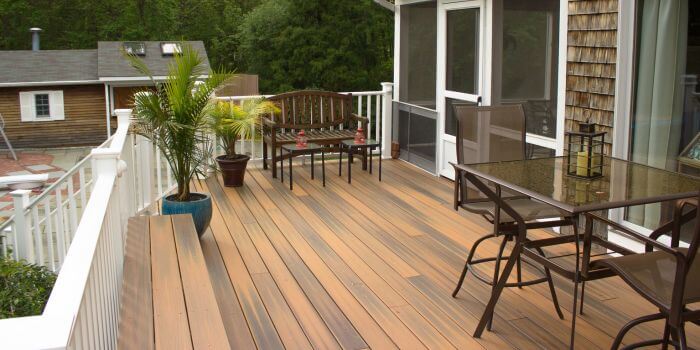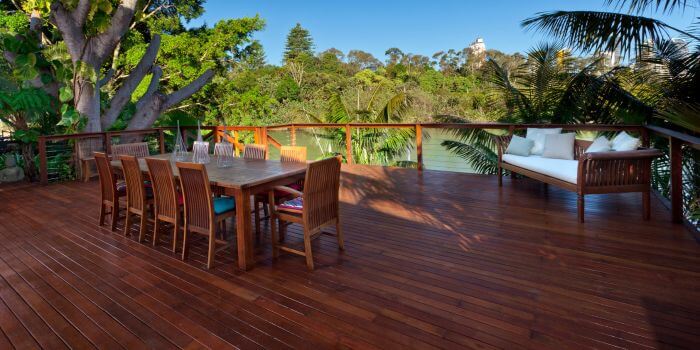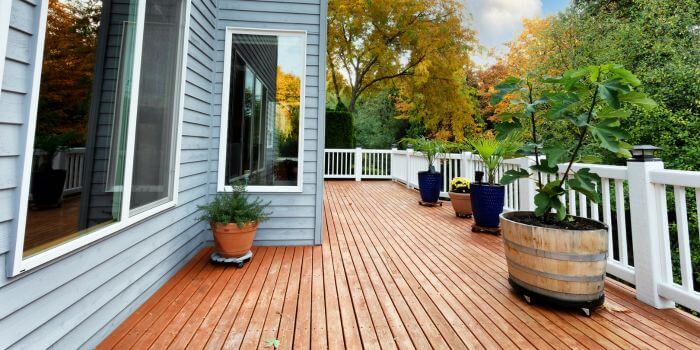Table of Contents
Deck’s Foundation
Are you dreaming of a beautiful deck where you can soak up the sun, host summer barbecues, or simply relax with a good book?
Well, before you dive into deck design and decoration, there’s a crucial foundation to consider – literally.
Your deck’s foundation material can make or break your outdoor oasis. In this guide, we’re going to explore different deck foundation materials, discuss their upsides and downsides, and help you figure out the perfect pick for your dream deck. Let’s kick things off by diving into the essentials.
Types of Deck Foundation Materials

The Time-Tested Option: Pressure-Treated Wood
When it comes to traditional deck foundations, pressure-treated wood reigns supreme. This material undergoes a unique treatment process to resist decay, so it’s a durable and budget-friendly choice.
But, there are a few trade-offs. Keeping your pressure-treated wood deck in tip-top shape requires some regular maintenance, such as staining or sealing.
But at the end of the day, it’s a small price to pay for a classic deck foundation that stands the test of time.
Nature’s Beauty on Your Doorstep: Cedar and Redwood
If aesthetics are high on your list, cedar and redwood may be your go-to options. These naturally beautiful woods offer unique grain patterns and warm hues, making your deck a showstopper.
Cedar is naturally resistant to decay, while redwood boasts impressive durability. However, this beauty comes at a price, both in terms of initial cost and upkeep.
The Modern Marvel: Composite Decking
Composite decking has taken the deck-building world by storm, and for good reason. It blends wood fibers and recycled plastic to create a low-maintenance, eco-friendly, and long-lasting foundation.
Say goodbye to sanding, staining, or splinters. Composite materials are available in a wide range of colors and styles, giving you plenty of design flexibility. But, it’s essential to weigh the upfront cost against the long-term savings.
Exotic and Extraordinary: Tropical Hardwood
If you want a touch of luxury, you’ll love tropical hardwoods like Ipe and Tigerwood. These dense, naturally durable woods are resistant to rot and pests, making them ideal for a long-lasting deck.
However, their rarity and hardness come with a hefty price tag. Additionally, consider the environmental implications when opting for these beautiful but less sustainable options.
The Sturdy Backbone: Steel Framing
When strength and durability are paramount, steel framing steps into the limelight. Steel can bear heavy loads, resist warping, and outlast other materials.
If you live in an area prone to earthquakes or severe weather, steel framing provides added stability.
Yet, it might not be the right choice for every budget, and it requires professional installation to ensure safety.
Rock-Solid Support: Concrete Piers and Footings
Concrete piers and footings provide a rock-solid foundation for your deck. They are particularly suitable for elevated or uneven terrains, offering stability and longevity.
However, the installation process can be more complex, and concrete may crack over time if not properly maintained.
Nevertheless, this option is worth considering for those seeking stability above all else.
Considerations for Choosing the Right Material

Now that we’ve explored these diverse deck foundation materials, how do you choose the right one for your project? Let’s break it down:
- Budget considerations
Your budget will play a significant role in your decision. Pressure-treated wood is budget-friendly, while exotic hardwoods and steel framing tend to be pricier. Balance your financial constraints with your long-term expectations.
- Climate and environmental factors
Consider your local climate and environmental concerns. Some materials, like composite decking, are eco-friendly and suitable for various climates. Others, like tropical hardwoods, may not be the best choice in terms of sustainability.
- Aesthetic preferences and design considerations
Do you have a specific style or color scheme in mind? Some materials offer more design flexibility than others. Consider how your chosen material will complement your home’s architecture and your personal style.
- Maintenance requirements and long-term costs
How much time and effort are you willing to invest in maintenance? Factor in the long-term costs of upkeep when making your decision. While some materials require minimal maintenance, others demand more attention.
Making Your Final Choice

Choosing the best foundation material for your deck can be a daunting task, but it doesn’t have to be. Here’s how to make an informed decision:
- Assess your unique needs and priorities.
Start by defining your priorities. Is longevity your top concern, or do you value low maintenance?
Are you working with a tight budget, or is aesthetics your primary focus? Knowing your needs will help you narrow down your options.
- Consult with experts.
Don’t hesitate to seek advice from professional deck builders, preferably someone experienced in custom deck design.
They can provide valuable insights based on your specific circumstances and location. Experienced professionals will be able to give you an accurate quote and a 3D rendering before getting started on the project.
- Weigh the pros and cons.
Take a careful look at the pros and cons of each material, considering your priorities. Consider factors like cost, maintenance, durability, and environmental impact.
- Make an informed decision.
Armed with information and expert advice, you can confidently choose the best foundation material for your dream deck.
Final Thoughts
So, what’s your dream deck made of? Is it the rustic charm of pressure-treated wood, the natural beauty of cedar, or the modern elegance of composite materials?
Perhaps it’s the exotic allure of tropical hardwoods or the unwavering strength of steel framing. Or, could it be the rock-solid support of concrete piers and footings?
Ultimately, the choice is yours, and it should reflect your unique needs, priorities, and style.
Your deck’s foundation is the bedrock of your outdoor space, so choose wisely. Whichever material you select, it will lay the groundwork for countless memorable moments spent in your outdoor haven.
Now, it’s over to you! What factors are most important to you when choosing your deck’s foundation material?
Have any questions or tips to share with fellow deck enthusiasts? Feel free to join the conversation and let us know your thoughts!
Also, Read
Cost-Effective Ways to Enhance The Durability of Your Wood Floor
What is Skirting? – Purpose & Types |Types of Skirting In Construction
18 Most Popular Types of Wood And Their Uses
What is a Floor Joist? |3 Types of Floor Joists |Floor Joist Spacing